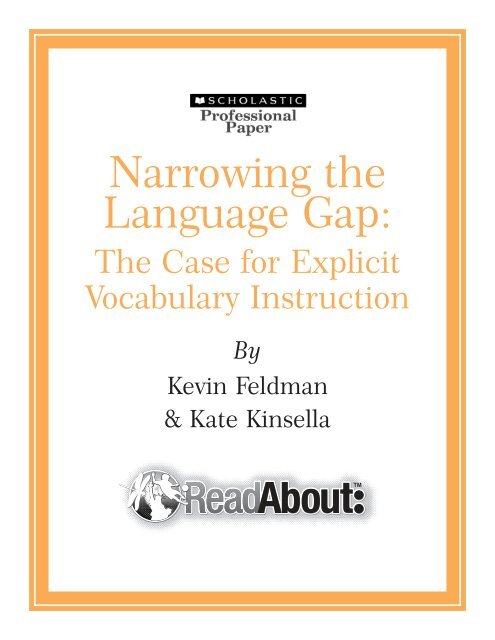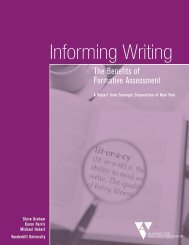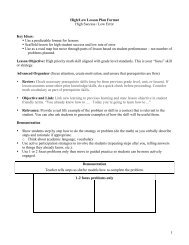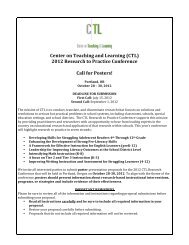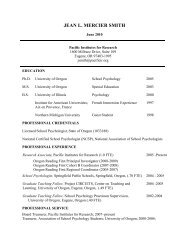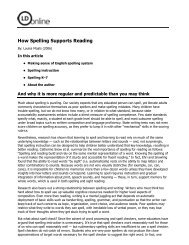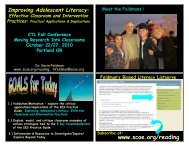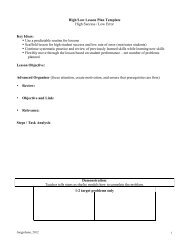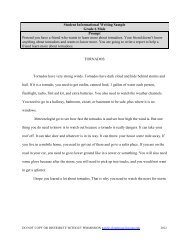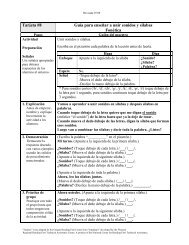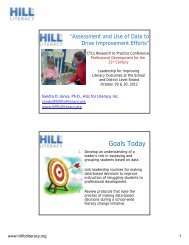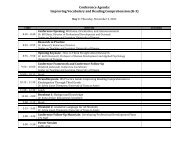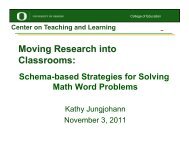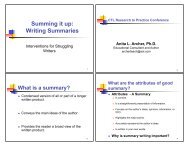Narrowing the Language Gap: - Center on Teaching and Learning ...
Narrowing the Language Gap: - Center on Teaching and Learning ...
Narrowing the Language Gap: - Center on Teaching and Learning ...
- No tags were found...
Create successful ePaper yourself
Turn your PDF publications into a flip-book with our unique Google optimized e-Paper software.
<str<strong>on</strong>g>Narrowing</str<strong>on</strong>g> <str<strong>on</strong>g>the</str<strong>on</strong>g><str<strong>on</strong>g>Language</str<strong>on</strong>g> <str<strong>on</strong>g>Gap</str<strong>on</strong>g>:The Case for ExplicitVocabulary Instructi<strong>on</strong>ByKevin Feldman& Kate KinsellaTM
TMWhat Doesn’t WorkPrior to explicating a research-informed process for both teaching <strong>and</strong> assessment,it is imperative to be mindful of <str<strong>on</strong>g>the</str<strong>on</strong>g> serious limitati<strong>on</strong>s inherent in <str<strong>on</strong>g>the</str<strong>on</strong>g> three mostcomm<strong>on</strong> vocabulary teaching practices in K–12 classrooms.1. Looking up words in <str<strong>on</strong>g>the</str<strong>on</strong>g> dicti<strong>on</strong>ary;2. Using written c<strong>on</strong>text to figure out word meanings;3. Unplanned, extemporaneous vocabulary teaching.While each of <str<strong>on</strong>g>the</str<strong>on</strong>g>se practices do have <str<strong>on</strong>g>the</str<strong>on</strong>g>ir place within a comprehensive literacyprogram, <str<strong>on</strong>g>the</str<strong>on</strong>g>y lack <str<strong>on</strong>g>the</str<strong>on</strong>g> efficacy <strong>and</strong> dependability required to serve as core tools to helpeducators aggressively narrow <str<strong>on</strong>g>the</str<strong>on</strong>g> lexical divide. In <str<strong>on</strong>g>the</str<strong>on</strong>g> secti<strong>on</strong> that follows, we willbriefly examine <str<strong>on</strong>g>the</str<strong>on</strong>g> inevitable short-comings of each of <str<strong>on</strong>g>the</str<strong>on</strong>g>se ubiquitous practices.Assigning words for students to look up in <str<strong>on</strong>g>the</str<strong>on</strong>g> dicti<strong>on</strong>aryC<strong>on</strong>siderable evidence indicates most children struggle when attempting to derivemeaning from c<strong>on</strong>venti<strong>on</strong>al dicti<strong>on</strong>ary definiti<strong>on</strong>s (Scott & Nagy, 1997; Marzano,2004). A brief examinati<strong>on</strong> of a typical classroom dicti<strong>on</strong>ary can easily show why.When developing a classroom dicti<strong>on</strong>ary, lexicographers strive to c<strong>on</strong>serve space inorder to include as many entries as possible. Therefore, definiti<strong>on</strong>s are customarilycrafted to be precise <strong>and</strong> c<strong>on</strong>cise, ir<strong>on</strong>ically omitting <str<strong>on</strong>g>the</str<strong>on</strong>g> very comp<strong>on</strong>ents that oftenare most critical to grasping <str<strong>on</strong>g>the</str<strong>on</strong>g> meaning of a new word: an accessible explanati<strong>on</strong>using familiar language <strong>and</strong> an age-appropriate example that is relevant to children’sown experiences.Directing students to derive meaning from c<strong>on</strong>textReading <strong>and</strong> language acquisiti<strong>on</strong> scholars seem to agree that, except for <str<strong>on</strong>g>the</str<strong>on</strong>g> firstfew thous<strong>and</strong> words in comm<strong>on</strong> oral usage, most vocabulary learning occurs throughextensive reading, with <str<strong>on</strong>g>the</str<strong>on</strong>g> reader guessing at <str<strong>on</strong>g>the</str<strong>on</strong>g> meaning of unknown words. Yet,while essential for l<strong>on</strong>g-term vocabulary growth, incidental learning from c<strong>on</strong>text is atbest an inefficient <strong>and</strong> unpredictable process. Research indicates <str<strong>on</strong>g>the</str<strong>on</strong>g> odds of deriving<str<strong>on</strong>g>the</str<strong>on</strong>g> intended meaning of an unknown word from written c<strong>on</strong>text is, unfortunately,extremely low, varying from 5% to 15% for both native speakers <strong>and</strong> Englishlanguagelearners (Beck et al. 2002; Nagy et al. 1985). <strong>Teaching</strong> students <str<strong>on</strong>g>the</str<strong>on</strong>g> wordlevel skills to successfully exploit c<strong>on</strong>text is vital to l<strong>on</strong>g term vocabulary acquisiti<strong>on</strong>;however, c<strong>on</strong>textual analysis should never be utilized as <str<strong>on</strong>g>the</str<strong>on</strong>g> primary or exclusiveinstructi<strong>on</strong>al strategy for supporting students’ comprehensi<strong>on</strong>.2
TMRelying primarily up<strong>on</strong> extemporaneous “teachable moments”Often, vocabulary instructi<strong>on</strong> in <str<strong>on</strong>g>the</str<strong>on</strong>g> classroom is unplanned, driven primarily bystudent questi<strong>on</strong>s <strong>and</strong> teacher intuiti<strong>on</strong>s. However, efficient <strong>and</strong> effective vocabularyinstructi<strong>on</strong> dem<strong>and</strong>s informed, intenti<strong>on</strong>al planning (Stahl, 1999). To resp<strong>on</strong>siblyprepare students for a challenging reading selecti<strong>on</strong>, a teacher must first criticallyanalyze <str<strong>on</strong>g>the</str<strong>on</strong>g> text to determine which words are most central to comprehensi<strong>on</strong> <strong>and</strong> thuswarrant more instructi<strong>on</strong>al time, <str<strong>on</strong>g>the</str<strong>on</strong>g>n c<strong>on</strong>sider how to teach <str<strong>on</strong>g>the</str<strong>on</strong>g>se terms in aproductive manner, c<strong>on</strong>veying both <str<strong>on</strong>g>the</str<strong>on</strong>g>ir meaning <strong>and</strong> import. Teachable moments canindeed enliven <strong>and</strong> pers<strong>on</strong>alize classroom interacti<strong>on</strong>s <strong>and</strong> deepen studentunderst<strong>and</strong>ings. However, we can’t excuse a lack of c<strong>on</strong>scientious vocabularypreparati<strong>on</strong> within less<strong>on</strong> planning in <str<strong>on</strong>g>the</str<strong>on</strong>g> name of creativity <strong>and</strong> student-centeredlearning. We should devote our intellectual <strong>and</strong> creative capital to thoughtful lexicalpreparati<strong>on</strong> <strong>and</strong> effective instructi<strong>on</strong>, <str<strong>on</strong>g>the</str<strong>on</strong>g>n tap into our reserves to resp<strong>on</strong>d productivelyto <str<strong>on</strong>g>the</str<strong>on</strong>g> inevitable challenges <strong>and</strong> questi<strong>on</strong>s that arise during <str<strong>on</strong>g>the</str<strong>on</strong>g> course of a less<strong>on</strong>.What Does Work: A ComprehensiveVocabulary Development ProgramIncreasing Reading Volume: Necessary but InsufficientTraditi<strong>on</strong>ally, most language experts viewed vocabulary as something more “caughtthan taught,” arguing <str<strong>on</strong>g>the</str<strong>on</strong>g>re are simply too many words to feasibly teach <strong>and</strong> thatincidental word learning via wide reading is resp<strong>on</strong>sible for most vocabularyacquisiti<strong>on</strong> (Nagy & Herman, 1985). Reading volume is undoubtedly very importantin terms of l<strong>on</strong>g-term vocabulary development (Cunningham & Stanovich, 1998);however, as previously noted, even with <str<strong>on</strong>g>the</str<strong>on</strong>g> most adept readers, incidental wordlearning is a protracted, inefficient, <strong>and</strong> unpredictable process, providing no way toanticipate which words will be learned, when, nor to what degree. Developing readerscannot be expected to simply “pick up” substantial vocabulary knowledge exclusivelythrough reading exposure without guidance. Specifically, teachers must design tasksthat will increase <str<strong>on</strong>g>the</str<strong>on</strong>g> effectiveness of vocabulary learning through reading practice.Rati<strong>on</strong>ale for Direct Vocabulary Instructi<strong>on</strong>Over <str<strong>on</strong>g>the</str<strong>on</strong>g> past two decades, mounting research has challenged traditi<strong>on</strong>al viewsregarding <str<strong>on</strong>g>the</str<strong>on</strong>g> role of direct teaching in vocabulary development. Numerous studieshave documented <str<strong>on</strong>g>the</str<strong>on</strong>g> positive impact of direct, explicit vocabulary instructi<strong>on</strong> <strong>on</strong> bothimmediate word learning <strong>and</strong> l<strong>on</strong>ger-term reading comprehensi<strong>on</strong> (Baker, Kame’enui,& Simm<strong>on</strong>s, 1995; Beck, McKeown, & Kucan, 2002; Biemiller, 2004; Marzano,2004). For example, Paribakht <strong>and</strong> Wesche (1997) compared incidental vocabulary3
TMattainment am<strong>on</strong>g students who learned vocabulary through ei<str<strong>on</strong>g>the</str<strong>on</strong>g>r independentreading or targeted instructi<strong>on</strong>. Their data showed that both approaches led toc<strong>on</strong>siderable gains over a three-m<strong>on</strong>th period. However, students learned more wordsthrough targeted instructi<strong>on</strong>, <strong>and</strong> learning exclusively through independent readingoften led to <strong>on</strong>ly a superficial underst<strong>and</strong>ing of many vocabulary words. Thus, <str<strong>on</strong>g>the</str<strong>on</strong>g>fundamental questi<strong>on</strong>, Is vocabulary best acquired indirectly via reading or directly viaexplicit teacher instructi<strong>on</strong>?, is itself, a false dichotomy. Students need a comprehensivevocabulary program that incorporates both direct <strong>and</strong> indirect approaches to lexicaldevelopment.A Model for Comprehensive Vocabulary DevelopmentLexical scholars tend to focus <str<strong>on</strong>g>the</str<strong>on</strong>g>ir research <strong>on</strong> very specific dimensi<strong>on</strong>s ofvocabulary growth, running <str<strong>on</strong>g>the</str<strong>on</strong>g> gamut from voluntary pleasure reading to explicitmorphemic analysis. We agree wholeheartedly with Graves’ (2000) visi<strong>on</strong> that abalanced or comprehensive model of vocabulary development must include fouressential elements.Research clearly indicates that while each comp<strong>on</strong>ent supports lexical growth, aschool-wide vocabulary development program integrating all four comp<strong>on</strong>ents holdsgreater potential for narrowing <str<strong>on</strong>g>the</str<strong>on</strong>g> language divide. For <str<strong>on</strong>g>the</str<strong>on</strong>g> purposes of this paper,however, we focus <strong>on</strong> <str<strong>on</strong>g>the</str<strong>on</strong>g> sec<strong>on</strong>d element, directly teaching new words, coupledwith strategies to ensure that students apply <str<strong>on</strong>g>the</str<strong>on</strong>g>ir newly acquired vocabulary inacademic speaking <strong>and</strong> writing c<strong>on</strong>texts.1. Wide Reading: Vocabulary grows as a c<strong>on</strong>sequence of independent reading <strong>and</strong>increasing reading volume (Cunningham & Stanovich, 1998; Nagy, Herman,& Anders<strong>on</strong>, 1985).2. Direct <strong>Teaching</strong> of Important Individual Words: Students learn new wordsvia various teacher-directed instructi<strong>on</strong>al strategies (Beck, McKeown, &Kucan, 2002; Stahl & Fairbanks, 1986).3. <strong>Teaching</strong> Word <strong>Learning</strong> Strategies: Students independently learn new wordmeanings when <str<strong>on</strong>g>the</str<strong>on</strong>g>y learn to use word learning strategies, such as exploringc<strong>on</strong>text <strong>and</strong> analyzing prefixes (Edwards, F<strong>on</strong>t, Baumann, & Bol<strong>and</strong>, 2004;Graves, 2000).4. Fostering Word C<strong>on</strong>sciousness: Vocabulary develops when students engage invarious activities to increase language play, word choice in writing, <strong>and</strong>sensitivity to word parts (Nagy & Scott, 2000).4
TMRobust Vocabulary Instructi<strong>on</strong>: A Powerful <strong>Teaching</strong> RoutineA distillati<strong>on</strong> of vocabulary research, toge<str<strong>on</strong>g>the</str<strong>on</strong>g>r with our 50 years of combinedclassroom experience, provides a clear foundati<strong>on</strong> for an effective <strong>and</strong> efficientvocabulary instructi<strong>on</strong>al routine. Something as rudimentary <strong>and</strong> essential to teachers ashow to teach an important new word effectively is rarely menti<strong>on</strong>ed in both languagearts <strong>and</strong> c<strong>on</strong>tent area curricula. Surprisingly, teacher’s editi<strong>on</strong>s of core curricula routinelydirect teachers to address central less<strong>on</strong> vocabulary with little more than <str<strong>on</strong>g>the</str<strong>on</strong>g> briefexhortati<strong>on</strong> to preview, cover, review, or introduce key terms. Meanwhile, <str<strong>on</strong>g>the</str<strong>on</strong>g>y neglect toprovide any explicit directi<strong>on</strong> in how to effectively <strong>and</strong> efficiently teach word meanings.The following steps can most certainly be elaborated <strong>and</strong> adapted, depending up<strong>on</strong><str<strong>on</strong>g>the</str<strong>on</strong>g> relative importance of <str<strong>on</strong>g>the</str<strong>on</strong>g> words in questi<strong>on</strong> <strong>and</strong> students’ background knowledge.However, in our experience, students greatly benefit from a c<strong>on</strong>sistent <strong>and</strong> recognizableapproach that incorporates <str<strong>on</strong>g>the</str<strong>on</strong>g> following steps:Instructi<strong>on</strong>al Steps1) Pr<strong>on</strong>ounce Classroom observati<strong>on</strong>s indicate that, far too frequently, <str<strong>on</strong>g>the</str<strong>on</strong>g> teacheris <str<strong>on</strong>g>the</str<strong>on</strong>g> <strong>on</strong>ly pers<strong>on</strong> who pr<strong>on</strong>ounces <strong>and</strong> uses <str<strong>on</strong>g>the</str<strong>on</strong>g> academic language of <str<strong>on</strong>g>the</str<strong>on</strong>g> disciplines.Thus, <str<strong>on</strong>g>the</str<strong>on</strong>g> first step in teaching a new term is guiding students in correctly pr<strong>on</strong>ouncing<str<strong>on</strong>g>the</str<strong>on</strong>g> word. This will support learners in decoding <str<strong>on</strong>g>the</str<strong>on</strong>g> word c<strong>on</strong>fidently, while alsosupporting both auditory <strong>and</strong> muscle memory (Shaywitz, 2003). Engage all students insaying <str<strong>on</strong>g>the</str<strong>on</strong>g> word toge<str<strong>on</strong>g>the</str<strong>on</strong>g>r two or three times. If it is a l<strong>on</strong>g <strong>and</strong>/or unusual term, it isoften helpful to emphasizing each syllable. For example:“One of our less<strong>on</strong> terms is accurate. It is an adjective or describing word. Pleasesay <str<strong>on</strong>g>the</str<strong>on</strong>g> word with me every<strong>on</strong>e: ‘Accurate.’ Good, let’s pr<strong>on</strong>ounce it by syllables:‘Ac cu rate.’ Say it again please: ‘Accurate.’ Excellent!”2) Explain Underst<strong>and</strong>ing <str<strong>on</strong>g>the</str<strong>on</strong>g> meaning of a new term requires a clear explanati<strong>on</strong>of <str<strong>on</strong>g>the</str<strong>on</strong>g> meaning, using language familiar to <str<strong>on</strong>g>the</str<strong>on</strong>g> students (Beck et al., 2002; Stahl,1999). If possible, provide a syn<strong>on</strong>ym or known phrase to solidify <str<strong>on</strong>g>the</str<strong>on</strong>g> c<strong>on</strong>necti<strong>on</strong>between <str<strong>on</strong>g>the</str<strong>on</strong>g> new vocabulary term <strong>and</strong> <str<strong>on</strong>g>the</str<strong>on</strong>g> student’s prior knowledge. Simplypresenting unintelligible dicti<strong>on</strong>ary or textual definiti<strong>on</strong>s is of little value until studentscan grasp <str<strong>on</strong>g>the</str<strong>on</strong>g> gist of what a word means, within <str<strong>on</strong>g>the</str<strong>on</strong>g> c<strong>on</strong>text of <str<strong>on</strong>g>the</str<strong>on</strong>g> language that isalready present in <str<strong>on</strong>g>the</str<strong>on</strong>g>ir lexic<strong>on</strong>.“The word ‘accurate’ means true, correct, or precise. I might say <str<strong>on</strong>g>the</str<strong>on</strong>g> report in <str<strong>on</strong>g>the</str<strong>on</strong>g>newspaper about our successful canned food drive was completely true; it wasabsolutely (students chorally say ‘accurate’).”3) Provide Examples Students will usually need at least two or three examples of anew term to firmly grasp <str<strong>on</strong>g>the</str<strong>on</strong>g> meaning. Moreover, <str<strong>on</strong>g>the</str<strong>on</strong>g>se examples should be drawnfrom a variety of c<strong>on</strong>texts, not <strong>on</strong>ly <str<strong>on</strong>g>the</str<strong>on</strong>g> <strong>on</strong>e used in <str<strong>on</strong>g>the</str<strong>on</strong>g> reading or less<strong>on</strong> (Baker et al.,5
TM1995; Beck et al., 2002). Multiple examples serve to build students’ semantic network,allowing <str<strong>on</strong>g>the</str<strong>on</strong>g>m to incorporate <str<strong>on</strong>g>the</str<strong>on</strong>g> term into <str<strong>on</strong>g>the</str<strong>on</strong>g>ir lexic<strong>on</strong> bey<strong>on</strong>d mere surfaceunderst<strong>and</strong>ing. It is helpful to phrase <str<strong>on</strong>g>the</str<strong>on</strong>g> examples such that <str<strong>on</strong>g>the</str<strong>on</strong>g> students repeat <str<strong>on</strong>g>the</str<strong>on</strong>g>target word in completing <str<strong>on</strong>g>the</str<strong>on</strong>g> example. This allows students to become morecomfortable using <str<strong>on</strong>g>the</str<strong>on</strong>g> word orally, a key step in building expressive vocabulary.“Test scores al<strong>on</strong>e do not always provide a true picture of <str<strong>on</strong>g>the</str<strong>on</strong>g> quality of a school.Test scores present an image that is not always (students say‘accurate’).”“When I check my bank account each m<strong>on</strong>th, I want to be sure <str<strong>on</strong>g>the</str<strong>on</strong>g> numbers arecorrect or .”4) Elaborate Research in cognitive psychology c<strong>on</strong>sistently indicates that learnersunderst<strong>and</strong> <strong>and</strong> remember informati<strong>on</strong> better when <str<strong>on</strong>g>the</str<strong>on</strong>g>y elaborate <strong>on</strong> it <str<strong>on</strong>g>the</str<strong>on</strong>g>mselves(Marzano et al., 2001). Thus, students’ underst<strong>and</strong>ing of new vocabulary terms isstreng<str<strong>on</strong>g>the</str<strong>on</strong>g>ned when <str<strong>on</strong>g>the</str<strong>on</strong>g>y are given opportunities to elaborate word meanings bygenerating <str<strong>on</strong>g>the</str<strong>on</strong>g>ir own additi<strong>on</strong>al examples <strong>and</strong> visual representati<strong>on</strong>s.“Imagine you are a reporter writing an article about our school. Come up with<strong>on</strong>e accurate <strong>and</strong> <strong>on</strong>e inaccurate statement about <str<strong>on</strong>g>the</str<strong>on</strong>g> school.”“Visualize a tabloid newspaper headline saying, ‘Elvis Lives!’ ”5) Assess Researchers such as Baker et al., (1995) <strong>and</strong> Marzano (2004) havedocumented <str<strong>on</strong>g>the</str<strong>on</strong>g> importance of incorporating regular informal vocabulary assessmentinto <str<strong>on</strong>g>the</str<strong>on</strong>g> instructi<strong>on</strong>al process, especially with academically diverse learners.Assessment of vocabulary involves both formative, quick informal checking forunderst<strong>and</strong>ing during <str<strong>on</strong>g>the</str<strong>on</strong>g> less<strong>on</strong>, <strong>and</strong> summative evaluati<strong>on</strong> as students subsequentlytake a formal quiz or test. In all forms of assessment, it is helpful to go bey<strong>on</strong>d simplememorizati<strong>on</strong> or matching tasks <strong>and</strong> require students to dem<strong>on</strong>strate some deeperlevel of thinking <strong>and</strong> underst<strong>and</strong>ing. Checks <strong>on</strong> underst<strong>and</strong>ing tend to fall into twobasic categories: discriminati<strong>on</strong> tasks, such as answering focused questi<strong>on</strong>s, <strong>and</strong>generative tasks, such as developing additi<strong>on</strong>al examples.Discriminati<strong>on</strong>: Focused Questi<strong>on</strong>s:“Is it accurate to say our school is <str<strong>on</strong>g>the</str<strong>on</strong>g> largest in town?”Generative Tasks:Completi<strong>on</strong> Activity:“Complete <str<strong>on</strong>g>the</str<strong>on</strong>g> following sentences so that <str<strong>on</strong>g>the</str<strong>on</strong>g> sec<strong>on</strong>d part fur<str<strong>on</strong>g>the</str<strong>on</strong>g>r explains <str<strong>on</strong>g>the</str<strong>on</strong>g> firstpart <strong>and</strong> clearly dem<strong>on</strong>strates your underst<strong>and</strong>ing of <str<strong>on</strong>g>the</str<strong>on</strong>g> underlined words.I could tell <str<strong>on</strong>g>the</str<strong>on</strong>g> newspaper article about our new gym was not accurate;”6
TMYes-No-Why Activity:“Decide whe<str<strong>on</strong>g>the</str<strong>on</strong>g>r <str<strong>on</strong>g>the</str<strong>on</strong>g> following sentences make sense, paying attenti<strong>on</strong> to <str<strong>on</strong>g>the</str<strong>on</strong>g>underlined words in each sentence. If <str<strong>on</strong>g>the</str<strong>on</strong>g> sentence makes sense, write YES in <str<strong>on</strong>g>the</str<strong>on</strong>g>space to <str<strong>on</strong>g>the</str<strong>on</strong>g> left, <str<strong>on</strong>g>the</str<strong>on</strong>g>n explain why it is logical. If <str<strong>on</strong>g>the</str<strong>on</strong>g> sentence does not makesense, write NO <strong>and</strong> explain why.School report cards always provide an accurate <strong>and</strong> reliabledescripti<strong>on</strong> of a student’s work.”Carrying <strong>Learning</strong> Fur<str<strong>on</strong>g>the</str<strong>on</strong>g>rThe basic instructi<strong>on</strong>al process outlined above is offered as a foundati<strong>on</strong>al strategy,not an end point. Since it takes multiple encounters with a word for a student toactually learn it, teachers need to provide instructi<strong>on</strong> that requires students to interactwith <str<strong>on</strong>g>the</str<strong>on</strong>g> word in a variety of ways within a c<strong>on</strong>densed period of time. It is importantto engage students in activities that will bolster <str<strong>on</strong>g>the</str<strong>on</strong>g>ir expressive vocabulary (i.e.speaking <strong>and</strong> writing) as well as <str<strong>on</strong>g>the</str<strong>on</strong>g>ir receptive vocabulary (i.e. listening <strong>and</strong> reading).There are limitless strategies to support students in developing <strong>and</strong> flexing <str<strong>on</strong>g>the</str<strong>on</strong>g>irlexical muscles. Here are a few of <str<strong>on</strong>g>the</str<strong>on</strong>g> most effective <strong>on</strong>es:Sample Vocabulary Note-Taking GuideIf vocabulary words are central to less<strong>on</strong> comprehensi<strong>on</strong> <strong>and</strong> required forsubsequent independent reading, writing, or listening tasks, it is imperative to helpstudents keep track of novel words through a note-taking scaffold (Marzano et al.,2001). A note-taking scaffold has multiple advantages in that it provides: (1) anadvance organizer of <str<strong>on</strong>g>the</str<strong>on</strong>g> most essential less<strong>on</strong> terms, (2) accountability for activestudent engagement during <str<strong>on</strong>g>the</str<strong>on</strong>g> less<strong>on</strong>, (3) a reference for later rehearsal <strong>and</strong> study.Word Syn<strong>on</strong>ym/Definiti<strong>on</strong> Example/Image/Showing Sentenceaccurate, adj. true, , exact, Rumors are often not .preciseinformati<strong>on</strong>. Image of tabloid headline,“Elvis is alive!!”reliable, adj dependable, some<strong>on</strong>e Our newspaper is always delivered byyou can <strong>on</strong> 6:00 A.M.; our carrier Luis is very. Image of a newspaper <strong>on</strong> <str<strong>on</strong>g>the</str<strong>on</strong>g>fr<strong>on</strong>t porch.7
TMWhen working with struggling readers, sec<strong>on</strong>d language learners, <strong>and</strong> o<str<strong>on</strong>g>the</str<strong>on</strong>g>r diversestudents, it is advisable to partially fill out <str<strong>on</strong>g>the</str<strong>on</strong>g> guide in advance, leaving blank certain keywords that students are directed to fill in during <str<strong>on</strong>g>the</str<strong>on</strong>g> course of instructi<strong>on</strong>. In this waystudents can focus <str<strong>on</strong>g>the</str<strong>on</strong>g>ir attenti<strong>on</strong> <strong>on</strong> comprehending <str<strong>on</strong>g>the</str<strong>on</strong>g> explanati<strong>on</strong> <strong>and</strong> examples,instead of getting bogged down in <str<strong>on</strong>g>the</str<strong>on</strong>g> writing process <strong>and</strong> missing vital c<strong>on</strong>tent.Gradually require students to assume more resp<strong>on</strong>sibility for filling in <str<strong>on</strong>g>the</str<strong>on</strong>g> guide, until<str<strong>on</strong>g>the</str<strong>on</strong>g>y can independently take notes <strong>on</strong> a blank vocabulary note-taking guide.Vocabulary Study StrategiesStudents benefit from learning efficient <strong>and</strong> effective strategies for reviewing,practicing, <strong>and</strong> elaborating newly acquired vocabulary terms after teacher-directedinstructi<strong>on</strong> (Baker et al., 1995; Marzano, 2004). Vocabulary study should be limited toless<strong>on</strong>-specific terms that are essential to comprehending <str<strong>on</strong>g>the</str<strong>on</strong>g> big ideas central to <str<strong>on</strong>g>the</str<strong>on</strong>g>subject matter <strong>and</strong> high-incidence academic terms that are needed to discuss <strong>and</strong>write about <str<strong>on</strong>g>the</str<strong>on</strong>g> topic.Three productive vocabulary study strategies are:1) Read, Cover, Recite, Check (RCRC; Archer & Gleas<strong>on</strong>, 2002), a verbal rehearsalstrategy in which students learn to read <str<strong>on</strong>g>the</str<strong>on</strong>g> word to <str<strong>on</strong>g>the</str<strong>on</strong>g>mselves, cover it up with<str<strong>on</strong>g>the</str<strong>on</strong>g>ir h<strong>and</strong>, recite <str<strong>on</strong>g>the</str<strong>on</strong>g> definiti<strong>on</strong> <strong>and</strong> related examples to <str<strong>on</strong>g>the</str<strong>on</strong>g>mselves, <strong>and</strong> <str<strong>on</strong>g>the</str<strong>on</strong>g>ncheck by reviewing <str<strong>on</strong>g>the</str<strong>on</strong>g> recorded informati<strong>on</strong> from <str<strong>on</strong>g>the</str<strong>on</strong>g> note-taking guide oro<str<strong>on</strong>g>the</str<strong>on</strong>g>r written record.2) Vocabulary Study Cards, wherein students create 3!! x 5!! cards c<strong>on</strong>taining usefulinformati<strong>on</strong> related to <str<strong>on</strong>g>the</str<strong>on</strong>g> term, such as: definiti<strong>on</strong>, syn<strong>on</strong>yms, examples <strong>and</strong>n<strong>on</strong>-examples, associated images, sentences, <strong>and</strong> <str<strong>on</strong>g>the</str<strong>on</strong>g> like. Students can study<str<strong>on</strong>g>the</str<strong>on</strong>g>ir cards individually (using rehearsal strategies like RCRC), with a partner,<strong>and</strong> in class-wide vocabulary games like Jeopardy.3) Vocabulary Notebooks, in which students write down terms pre-taught by <str<strong>on</strong>g>the</str<strong>on</strong>g>teacher as well as self-selected terms that students cull from <str<strong>on</strong>g>the</str<strong>on</strong>g> reading. It ishelpful to have an explicit organizati<strong>on</strong>al scheme for what informati<strong>on</strong> is recordedin <str<strong>on</strong>g>the</str<strong>on</strong>g> notebook, such as: syn<strong>on</strong>yms, images, sentences, part of speech, etc.Accountable C<strong>on</strong>texts for Speaking <strong>and</strong> WritingAll too often, <str<strong>on</strong>g>the</str<strong>on</strong>g> teacher is <str<strong>on</strong>g>the</str<strong>on</strong>g> <strong>on</strong>ly individual in <str<strong>on</strong>g>the</str<strong>on</strong>g> classroom who uses actualacademic language, while students are allowed to passively listen or use casual, dailyvernacular. If <strong>on</strong>e of our instructi<strong>on</strong>al priorities is significantly narrowing <str<strong>on</strong>g>the</str<strong>on</strong>g> lexicaldivide, we must structure daily classroom c<strong>on</strong>texts so that all students are accountablefor using newly introduced terminology in <str<strong>on</strong>g>the</str<strong>on</strong>g>ir speaking <strong>and</strong> writing. Students withimpoverished academic vocabulary <strong>and</strong> little self c<strong>on</strong>fidence will need more thanencouraging words <strong>and</strong> motivating topics to develop rich, expressive vocabulary for8
TMscholastic success (Dutro & Moran, 2003; Fillmore & Snow, 2000; Gersten & Baker,2000; Scarcella, 1996). Students benefit greatly from brief, daily classroomopportunities to use academic language in speaking <strong>and</strong> writing. One efficient way toget students to apply academic language is to provide opportunities for “preparedparticipati<strong>on</strong>,” which affords <str<strong>on</strong>g>the</str<strong>on</strong>g>m time to collect <str<strong>on</strong>g>the</str<strong>on</strong>g>ir thoughts <strong>and</strong> complete awritten resp<strong>on</strong>se starter. For example, in discussing <str<strong>on</strong>g>the</str<strong>on</strong>g> topic of bullying prior to areading, a teacher could set <str<strong>on</strong>g>the</str<strong>on</strong>g> stage by asking students to first compile an individuallist of examples of bullying <str<strong>on</strong>g>the</str<strong>on</strong>g>y had witnessed or heard of. After this initial ideagenerati<strong>on</strong>, students could be given a few sentence starters like <str<strong>on</strong>g>the</str<strong>on</strong>g> following (includingkey terms from <str<strong>on</strong>g>the</str<strong>on</strong>g> relevant vocabulary list) <strong>and</strong> directed to write two sentences in <str<strong>on</strong>g>the</str<strong>on</strong>g>irnotebook in preparati<strong>on</strong> for <str<strong>on</strong>g>the</str<strong>on</strong>g> discussi<strong>on</strong>.“One form of verbal/n<strong>on</strong>-verbal bullying I have witnessed in our school is …”“I am aware of several forms of verbal/n<strong>on</strong>-verbal bullying at our school, but <str<strong>on</strong>g>the</str<strong>on</strong>g>most serious is …”Students could be prompted to rehearse <str<strong>on</strong>g>the</str<strong>on</strong>g>ir favorite example sentence with apartner in preparati<strong>on</strong> for a subsequent class discussi<strong>on</strong>. The teacher could <str<strong>on</strong>g>the</str<strong>on</strong>g>n lead adiscussi<strong>on</strong> of <str<strong>on</strong>g>the</str<strong>on</strong>g>se examples within a structured Idea Wave, allowing multiple studentsto read <strong>on</strong>e prepared sentence aloud while syn<str<strong>on</strong>g>the</str<strong>on</strong>g>sizing <strong>and</strong> elaborating as appropriate.<strong>Teaching</strong> Words that Matter MostIntensive vocabulary instructi<strong>on</strong> is absolutely necessary to produce in-depth wordknowledge. However, <strong>on</strong>ly a fracti<strong>on</strong> of <str<strong>on</strong>g>the</str<strong>on</strong>g> potentially unfamiliar words in ast<strong>and</strong>ards-based, cognitively dem<strong>and</strong>ing less<strong>on</strong> can be taught, particularly within adiverse, mixed-ability classroom. Thus, <str<strong>on</strong>g>the</str<strong>on</strong>g> first challenge is to determine which wordswarrant direct <strong>and</strong> detailed teaching. Without careful analysis of <str<strong>on</strong>g>the</str<strong>on</strong>g> lexical dem<strong>and</strong>sof a text, a teacher can squ<strong>and</strong>er vital instructi<strong>on</strong>al time <strong>on</strong> words that may beunfamiliar but have little bearing <strong>on</strong> comprehensi<strong>on</strong> of <str<strong>on</strong>g>the</str<strong>on</strong>g> focal c<strong>on</strong>cepts.Intensive instructi<strong>on</strong> is most worthwhile ei<str<strong>on</strong>g>the</str<strong>on</strong>g>r when words are related to <str<strong>on</strong>g>the</str<strong>on</strong>g> centralless<strong>on</strong> c<strong>on</strong>cepts or when words have general utility in academic c<strong>on</strong>texts. Although wewant to engender curiosity <strong>and</strong> playfulness with language learning, it is easy to engage in“lexical accessorizing” throughout a less<strong>on</strong>, spending an inordinate amount of timeexplicating words peripheral to <str<strong>on</strong>g>the</str<strong>on</strong>g> central <str<strong>on</strong>g>the</str<strong>on</strong>g>mes <strong>and</strong> issues, yet intriguing to <str<strong>on</strong>g>the</str<strong>on</strong>g>teacher or a small cadre of precocious students.Relying <strong>on</strong> publishers to designate <str<strong>on</strong>g>the</str<strong>on</strong>g>words that warrant instructi<strong>on</strong> can be derailing <strong>and</strong> unproductive. Textbook publishersoften highlight words simply because <str<strong>on</strong>g>the</str<strong>on</strong>g>y are rarely used or idiomatic. <str<strong>on</strong>g>Language</str<strong>on</strong>g> Artsmaterials have <str<strong>on</strong>g>the</str<strong>on</strong>g> greatest tendency to focus heavily <strong>on</strong> unusual or provocative wordsfor <str<strong>on</strong>g>the</str<strong>on</strong>g> more sophisticated reader, while neglecting central less<strong>on</strong> terms <strong>and</strong> high-utilityacademic words that are vital for less proficient readers. The o<str<strong>on</strong>g>the</str<strong>on</strong>g>r core subject areas9
TMcharacteristically provide a fairly reliable list of less<strong>on</strong>-specific terms tied to c<strong>on</strong>tentst<strong>and</strong>ards, while neglecting to menti<strong>on</strong> high use academic terms students will encounteracross <str<strong>on</strong>g>the</str<strong>on</strong>g> disciplines. For example, in a sixth-grade U.S. History chapter addressing <str<strong>on</strong>g>the</str<strong>on</strong>g>American Revoluti<strong>on</strong>, terms such as Patriot, Loyalist, <strong>and</strong> Stamp Act will predictably behighlighted. However, <str<strong>on</strong>g>the</str<strong>on</strong>g> plethora of vocabulary necessary for students to underst<strong>and</strong><strong>and</strong> discuss <str<strong>on</strong>g>the</str<strong>on</strong>g> cause/effect relati<strong>on</strong>ships of this historical period will not be clarified(e.g. impact, subsequent, c<strong>on</strong>sequences). Because of <str<strong>on</strong>g>the</str<strong>on</strong>g> sketchy <strong>and</strong> ra<str<strong>on</strong>g>the</str<strong>on</strong>g>r arbitrarynature of key terms selected by publishers, it is incumbent up<strong>on</strong> teachers to have a viableframework for choosing words that require planned explicit teaching.Guidelines for Choosing Words to Teach• Choose “big idea” words that name or relate to <str<strong>on</strong>g>the</str<strong>on</strong>g> central c<strong>on</strong>cepts addressed in <str<strong>on</strong>g>the</str<strong>on</strong>g>passage (e.g. democracy, independence, fossil fuels, ecology).• Choose high-use, widely applicable “academic tool kit” words that students are likelyto encounter in diverse materials across subject areas <strong>and</strong> grade levels (e.g., aspect,compare, similar, subsequently).• Choose high-use “disciplinary tool kit” words that are relevant to your subject area<strong>and</strong> that you c<strong>on</strong>sider vital for students to master at this age <strong>and</strong> proficiency level(e.g., metaphor, policy, ec<strong>on</strong>omic, applicati<strong>on</strong>, species).• Choose “polysemous” (multiple meaning) words that have a new academic meaningin reading in additi<strong>on</strong> to a more general, familiar meaning (e.g., wave as in “wave ofimmigrants” vs. a greeting or ocean wave).• Especially when dealing with narrative texts, identify additi<strong>on</strong>al academic words (notincluded in <str<strong>on</strong>g>the</str<strong>on</strong>g> reading selecti<strong>on</strong>) that students will need to know in order to engagein academic discourse about <str<strong>on</strong>g>the</str<strong>on</strong>g> central characters, issues, <strong>and</strong> <str<strong>on</strong>g>the</str<strong>on</strong>g>mes.C<strong>on</strong>cluding ThoughtsWord poverty <strong>and</strong> its attendant woes are beginning to merit much-deservedattenti<strong>on</strong>. Schools need to commit <str<strong>on</strong>g>the</str<strong>on</strong>g>mselves to implementing rigorous <strong>and</strong> informedvocabulary <strong>and</strong> language development programs so that <str<strong>on</strong>g>the</str<strong>on</strong>g>y can aggressively address<str<strong>on</strong>g>the</str<strong>on</strong>g> challenges inherent in narrowing <str<strong>on</strong>g>the</str<strong>on</strong>g> endemic language divide. Teachers across <str<strong>on</strong>g>the</str<strong>on</strong>g>grade levels <strong>and</strong> subject areas have to work collaboratively to shoulder <str<strong>on</strong>g>the</str<strong>on</strong>g> resp<strong>on</strong>sibilityof equipping students with <str<strong>on</strong>g>the</str<strong>on</strong>g> lexical skills to successfully navigate today’s high-stakes,st<strong>and</strong>ards-based educati<strong>on</strong>al envir<strong>on</strong>ment. We must keep in mind, however, thatteaching vocabulary robustly is not an end in itself but <strong>on</strong>ly a means to an end. Thecritical outcome is how well we equip students to thrive in academic c<strong>on</strong>texts.10
TMREFERENCESArcher, A., & Gleas<strong>on</strong>, M. (2002). Skills for schoolsuccess. North Billerica, MA: Curriculum Associates.Baker, S. K., Simm<strong>on</strong>s, D. C., & Kameenui, E. J. (1995).Vocabulary Acquisiti<strong>on</strong>: Syn<str<strong>on</strong>g>the</str<strong>on</strong>g>sis of <str<strong>on</strong>g>the</str<strong>on</strong>g> Research.(Tech. Rep. No. 13). Eugene: University of Oreg<strong>on</strong>,Nati<strong>on</strong>al <str<strong>on</strong>g>Center</str<strong>on</strong>g> to Improve <str<strong>on</strong>g>the</str<strong>on</strong>g> Tools of Educators.Biemiller, A. (2004) <strong>Teaching</strong> Vocabulary in <str<strong>on</strong>g>the</str<strong>on</strong>g> PrimaryGrades: Vocabulary Instructi<strong>on</strong> Needed, In J.F. Baumann& E.J. Kame’enui (Eds.), Vocabulary instructi<strong>on</strong>: Fromresearch to practice (pp. 159–176). New York: GuilfordPress.Baumann, J.F., & Kame’enui, E.J. (Eds.; 2004).Vocabulary instructi<strong>on</strong>: From research to practice.New York: Guilford Press.Beck, I.L., McKeown, M.G., & Kucan, L. (2002).Bringing words to life: Robust vocabulary instructi<strong>on</strong>.New York: Guilford Press.Carlo, M.S., August, D., McLaughlin, B., Snow, C.E.,Dressler, C., Lippman, D.N., Lively, T.J., & White, C.E.(2004). Closing <str<strong>on</strong>g>the</str<strong>on</strong>g> gap: Addressing <str<strong>on</strong>g>the</str<strong>on</strong>g> vocabulary needsof English language learners in bilingual <strong>and</strong> mainstreamclassroom. Reading Research Quarterly, 39, 188–215.Chall, J. S., Jacobs, V. A., & Baldwin, L. E. (1990). Thereading crisis: Why poor children fall behind.Cambridge: Harvard University Press.Chall, J. S. (2000). The academic achievement challenge:What really works in <str<strong>on</strong>g>the</str<strong>on</strong>g> classroom? New York: GuilfordPress.Curtis, M.E., & L<strong>on</strong>go, A.M. (1999). When adolescentscan’t read: Methods <strong>and</strong> materials that work.Cambridge: Brookline.Cunningham, A.E., & Stanovich, K.E. (1998).What reading does for <str<strong>on</strong>g>the</str<strong>on</strong>g> mind. American Educator,22 (1–2), 8–15.Durkin, D. (1979). What classroom observati<strong>on</strong>s revealabout reading comprehensi<strong>on</strong> instructi<strong>on</strong>. ReadingResearch Quarterly, 14, 481–538.Dutro, S., & Moran, C. (2003). Rethinking Englishlanguage instructi<strong>on</strong>: An architectural approach. In G.Garcia (Ed.)., English learners: Reaching <str<strong>on</strong>g>the</str<strong>on</strong>g> highestlevel of English literacy (pp. 227–258). Newark, DE:Internati<strong>on</strong>al Reading Associati<strong>on</strong>.Duke, N. (2004) The case for informati<strong>on</strong>al text.Educati<strong>on</strong>al Leadership, 61, 6, 40–45.Edwards, E.C., F<strong>on</strong>t, G., Baumann, J.F., & Bol<strong>and</strong>, E.(2004). Unlocking word meanings. In J.F. Baumann & E.J.Kame’enui (Eds.), Vocabulary instructi<strong>on</strong>: From researchto practice (pp. 159–176). New York: Guilford Press.Fillmore, L.W, & Snow, C.E. (2000). What teachers needto know about language. Special report from ERICClearinghouse <strong>on</strong> language <strong>and</strong> linguistics (Online).Available: http://www.cal.org/ericcll/teachers/teachers.pdfGersten, R., & Baker, S. (2000). Effective instructi<strong>on</strong> forEnglish-language learners: What we know about effectiveinstructi<strong>on</strong>al practices for English-language learners.Excepti<strong>on</strong>al Children, 66, 4, 454–470.Graves, M.F. (2000). A vocabulary program tocompliment <strong>and</strong> bolster a middle grade comprehensi<strong>on</strong>program. In B.M. Taylor, M.F. Graves, <strong>and</strong> P. van denBroek (Eds.), Reading for meaning: Fosteringcomprehensi<strong>on</strong> in <str<strong>on</strong>g>the</str<strong>on</strong>g> middle grades (pp. 116–135),Newark, DE: Internati<strong>on</strong>al Reading Associati<strong>on</strong>.Juel, C., & Deffes, R. (2004). Making words stick.Educati<strong>on</strong>al Leadership, 63, 6, 30–34.Hart, B., & Risley, T.R. (1995). Meaningful differencesin <str<strong>on</strong>g>the</str<strong>on</strong>g> everyday experience of young American children.Baltimore: Paul H. Brookes.Hirsch, E.D. (2003, Spring). Reading comprehensi<strong>on</strong>requires knowledge of words <strong>and</strong> <str<strong>on</strong>g>the</str<strong>on</strong>g> world: Scientificinsights into <str<strong>on</strong>g>the</str<strong>on</strong>g> fourth-grade slump <strong>and</strong> <str<strong>on</strong>g>the</str<strong>on</strong>g> nati<strong>on</strong>’sstagnant comprehensi<strong>on</strong> scores. American Educator,10–20.Kuhn, M.R., & Stahl, S.A. (1998). <strong>Teaching</strong> children tolearn word meanings from c<strong>on</strong>text: A syn<str<strong>on</strong>g>the</str<strong>on</strong>g>sis <strong>and</strong> somequesti<strong>on</strong>s. Journal of Literacy Research, 30, 19–38.Marzano, R.J. (2004). The developing visi<strong>on</strong> of vocabularyinstructi<strong>on</strong>. In J.F. Baumann & E.J. Kame’enui (Eds.),Vocabulary instructi<strong>on</strong>: From research to practice(pp. 159–176). New York: Guilford Press.Marzano, R.J., Pickering, D.J., & Pollock, J.E. (2001).Classroom instructi<strong>on</strong> that works: Research basedstrategies for increasing student achievement.Alex<strong>and</strong>ria, VA:Associati<strong>on</strong> for Supervisi<strong>on</strong> <strong>and</strong>Curriculum Development.11
TMMcKeown, M.G. (1985). The acquisiti<strong>on</strong> of word meaningform c<strong>on</strong>text by children of high <strong>and</strong> low-ability. ReadingResearch Quarterly, 20, 482–496.Moats, L. (2001, Summer). Overcoming <str<strong>on</strong>g>the</str<strong>on</strong>g> language gap.American Educator, 5–9.McIntosh, R. & Vaughn, S. (1994). Observati<strong>on</strong>s ofstudents with learning disabilities in general educati<strong>on</strong>classrooms. Excepti<strong>on</strong>al Children, 60, 3, 249– 262.Nagy,W.E., Herman, P.A., & Anders<strong>on</strong>, R.C. (1985).<strong>Learning</strong> words from c<strong>on</strong>text. Reading ResearchQuarterly, 20, 233–253.Nagy,W.E., & Scott, J.A. (2000). Vocabulary processes. InM.L. Kamil, P.B. Mosenthal, David Pears<strong>on</strong>, & R. Barr(Eds.), H<strong>and</strong>book of reading research, vol. 3 (pp.269–284). Mahwah, NJ: Erlbaum.Nati<strong>on</strong>al Assessment of Educati<strong>on</strong>al Progress. (2004).Group results for sex, regi<strong>on</strong>, <strong>and</strong> size of community.Washingt<strong>on</strong>, DC: U.S. Government Printing Office.Nati<strong>on</strong>al Reading Panel. (2000). <strong>Teaching</strong> children toread: An evidence-based assessment of <str<strong>on</strong>g>the</str<strong>on</strong>g> scientificliterature <strong>on</strong> reading <strong>and</strong> its implicati<strong>on</strong>s for readinginstructi<strong>on</strong>. Be<str<strong>on</strong>g>the</str<strong>on</strong>g>sda, MD: Nati<strong>on</strong>al Institute of ChildHealth <strong>and</strong> Human Development (NICHD).Paribakht, T.S., & Wesche, M. (1997). Vocabularyenhancement activities <strong>and</strong> reading for meaning in sec<strong>on</strong>dlanguage vocabulary acquisiti<strong>on</strong>. In J. Coady, T. Huckin,M.H. L<strong>on</strong>g, & J.C. Richards (Eds.), Sec<strong>on</strong>d languagevocabulary acquisiti<strong>on</strong>: A rati<strong>on</strong>ale for pedagogy (pp.174–199). New York: Cambridge University Press.Saville-Troike, M. (1984). What really matters in sec<strong>on</strong>dlanguage learning for academic achievement? “TESOLQuarterly, (18)”2..Scarcella, R.C. (1996). Sec<strong>on</strong>dary educati<strong>on</strong> <strong>and</strong> sec<strong>on</strong>dlanguage research: ESL students in <str<strong>on</strong>g>the</str<strong>on</strong>g> 1990’s. TheCATESOL Journal, 9, 129–152.Schatz, E.K., & Baldwin, R.S. (1986). C<strong>on</strong>text clues areunreliable predictors of word meanings. Reading ResearchQuarterly, 21, 439–453.Schleppegrell, M. (2002). Linguistic features of <str<strong>on</strong>g>the</str<strong>on</strong>g>language of schooling. Linguistics <strong>and</strong> Educati<strong>on</strong>, 12,431–459.Schmitt, N., & Carter, R. (2000). The lexical advantages ofnarrow reading for sec<strong>on</strong>d language learners. TESOLJournal, 9, 4–9.Scott, J.A., & Nagy, W.E. (1997). Underst<strong>and</strong>ing <str<strong>on</strong>g>the</str<strong>on</strong>g>definiti<strong>on</strong>s of unfamiliar words. Reading ResearchQuarterly, 32, 184–200.Shaywitz, S. (2003). Overcoming dyslexia: A new <strong>and</strong>complete science-based program for reading problems atany level. New York: Knopf.Stahl, S.A. (1999). Vocabulary Development. Cambridge:Brookline.Stahl, S.A., & Fairbanks, M.M. (1987). The effects ofvocabulary instructi<strong>on</strong>: A model-based meta-analysis.Review of Educati<strong>on</strong>al Research, 56, 72–110.12
ABOUT THE AUTHORSDr. Kate Kinsella is a teacher educator in <str<strong>on</strong>g>the</str<strong>on</strong>g>Department of Sec<strong>on</strong>dary Educati<strong>on</strong> at San FranciscoState University. She addresses academic language <strong>and</strong>literacy development in linguistically <strong>and</strong> culturallydiverse classrooms. She also teaches adolescentEnglish-language learners through <str<strong>on</strong>g>the</str<strong>on</strong>g> University’s Stepto College Program. She publishes <strong>and</strong> provides trainingnati<strong>on</strong>ally, sharing resp<strong>on</strong>sible instructi<strong>on</strong>al practicesthat provide sec<strong>on</strong>d language learners <strong>and</strong> lessproficientreaders in Grades 4–12 with <str<strong>on</strong>g>the</str<strong>on</strong>g> language <strong>and</strong>literacy skills vital to educati<strong>on</strong>al mobility.WILHELMPHOTO TKDr. Kinsella is co-author of Scholastic’s interventi<strong>on</strong>program, READ 180. She is <str<strong>on</strong>g>the</str<strong>on</strong>g> program c<strong>on</strong>sultant for Reading in <str<strong>on</strong>g>the</str<strong>on</strong>g> C<strong>on</strong>tent Areas:Strategies for Reading Success, published by Globe Fear<strong>on</strong>/Pears<strong>on</strong> <strong>Learning</strong>, <strong>and</strong> <str<strong>on</strong>g>the</str<strong>on</strong>g> leadc<strong>on</strong>sultant for <str<strong>on</strong>g>the</str<strong>on</strong>g> 2002 Prentice Hall sec<strong>on</strong>dary language arts series Timeless Voices:Timeless Themes.She is <str<strong>on</strong>g>the</str<strong>on</strong>g> 2002 recipient of <str<strong>on</strong>g>the</str<strong>on</strong>g> prestigious Marcus Foster MemorialReading Award, offered to an educator who has made a significant statewide impact <strong>on</strong>literacy in California.Dr. Kevin Feldman is <str<strong>on</strong>g>the</str<strong>on</strong>g> Director of Reading <strong>and</strong>Early Interventi<strong>on</strong> with <str<strong>on</strong>g>the</str<strong>on</strong>g> S<strong>on</strong>oma County Office ofEducati<strong>on</strong> (SCOE). He develops, organizes, <strong>and</strong>m<strong>on</strong>itors programs related to K–12 literacy <strong>and</strong>preventi<strong>on</strong> of reading difficulties. He also serves as aLeadership Team C<strong>on</strong>sultant to <str<strong>on</strong>g>the</str<strong>on</strong>g> California Reading<strong>and</strong> Literature Project <strong>and</strong> assists in <str<strong>on</strong>g>the</str<strong>on</strong>g> development<strong>and</strong> implementati<strong>on</strong> of PreK–12 programs throughoutCalifornia <strong>and</strong> across <str<strong>on</strong>g>the</str<strong>on</strong>g> nati<strong>on</strong>.Dr.Feldman’s primary focus is <strong>on</strong> literacy. His majorc<strong>on</strong>tributi<strong>on</strong>s are in <str<strong>on</strong>g>the</str<strong>on</strong>g> areas of assisting strugglingreaders, preventing reading failure, linking assessmentto instructi<strong>on</strong>, developing school-wide reading supportmodels, differentiating instructi<strong>on</strong> to meet <str<strong>on</strong>g>the</str<strong>on</strong>g> full range of learners, <strong>and</strong>accommodating <strong>and</strong> accelerating EL/Special Educati<strong>on</strong> <strong>and</strong> o<str<strong>on</strong>g>the</str<strong>on</strong>g>r high risk students.Dr.Feldman serves as a c<strong>on</strong>sultant to <str<strong>on</strong>g>the</str<strong>on</strong>g> California Reading & Literature Project,PreK–12; CalSTAT Statewide Special Educati<strong>on</strong> Reform Project; <strong>and</strong> a number ofpublishers <strong>and</strong> literacy organizati<strong>on</strong>s.Dr.Feldman recently co-authored <str<strong>on</strong>g>the</str<strong>on</strong>g> California Special Educati<strong>on</strong> Reading Task ForceReport.He has taught for 19 years at <str<strong>on</strong>g>the</str<strong>on</strong>g> university level in Special Educati<strong>on</strong><strong>and</strong> Masters’ level programs for University of California, Riverside <strong>and</strong> S<strong>on</strong>oma StateUniversity. To learn more about Dr. Feldman’s work, please visit <str<strong>on</strong>g>the</str<strong>on</strong>g> SCOE Web site(www.scoe.org) <strong>and</strong> click <strong>on</strong> The Reading Corner.13
TMTMScholastic Inc.557 BroadwayNew York, NY 10012Copyright © 2004 by Scholastic Inc. All rights reserved. ISBN 0-439-74224-2


